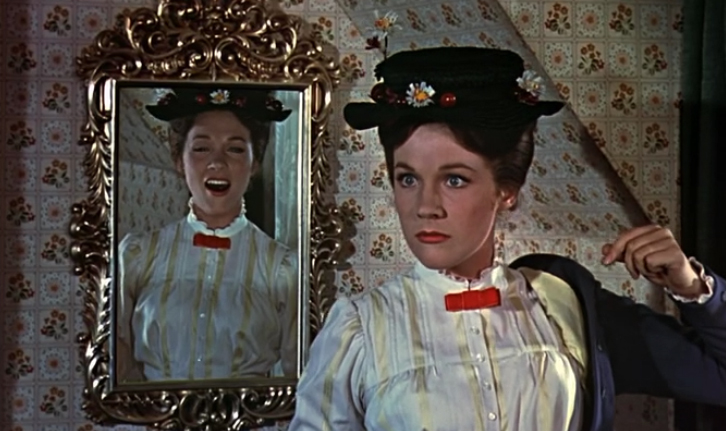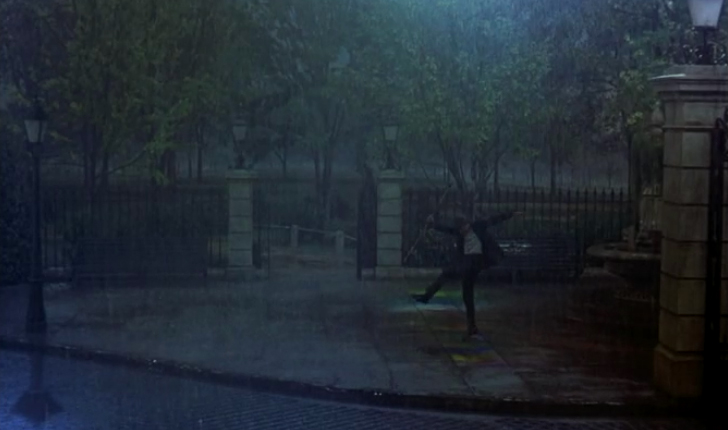Let me make one thing perfectly clear: Mary Poppins never explains anything! That's true of both the character and the film, actually. There's no back story (Hallelujah!) and no fussiness about the how and why of her "magic". (Sadly, this movie would never be made today when the mystery is drained from everything). More surprising for a family film there's very little overstating of its message (though Dick Van Dyke does a little bit of singing it directly to Mr. Banks just to make sure he's clear). If you don't believe me, really watch it again. Despite the imposing length (2 hours and 20 minutes) it's structurally smart and so light on its feet that it simply blows in on the East wind and then floats away when the super nanny's mission is accomplished. Like its heroine, the movie is practically perfect in every way.
 "Cheeky" - my favorite shot of Julie Andrews in the film
"Cheeky" - my favorite shot of Julie Andrews in the film
I'll do my best to emulate her and keep my "best shot" explanation brief -- if only I could sing it! though it's a bittersweet task since, if I was choosing a different shot, I'd get to talk at length about how brilliant Julie Andrews is in the movie. Her Oscar win is one of the most unusual choices the Academy ever made for a Lead Acting trophy (no histrionics, no "clips", nothing one might define as Oscar-Bait) and one of their smartest, too. But I'll have to wax rhapsodic about Julie another time and jump right to my choice for Best Shot.
When I was a kid my favorite song in the movie was "Jolly Holiday". I'm not sure if it was because I wanted to dive into the chalk paintings or if I just found it catchy or if I just loved that incredibly funny moment when all the barnyard animals get solo lines and they each sound EXACTLY like a singing version of that animal should. As an adult I still love the song mostly because its such an accurate description of how one feels in Mary Poppins presence: light and grand... your heart starts beating like a big brass band.
 Best Shot -- I wish I could see this on the big screen!
Best Shot -- I wish I could see this on the big screen!
But, as anyone familiar with Mary Poppins know, there's a beautiful melancholy undercurrent to the plot and the feeling which is why I'm choosing this moment, right after the chalk painting adventure when Mary and the children have left Bert in the park. It's gray and stormy now but Bert's mood is unaltered. He keeps dancing in the rain, still enjoying the imagined holiday as the colors lose their shape but glow like memories.
This visual motif with a man in near silhouette with a telling splash of color is repeated again (only more empathically) in both the showstopping "Steppin' Time" number (blue) and when Mr Banks is fired from his job (red) but here is where it most beautifully summarizes the film's smart disposition (both firm and truthful but loose and magical) and the color Mary brings to people's lives.
When the day is gray and ordinary
Mary makes the sun shine bright!
Mary Poppins warns us over and over again -- though not in hamfisted redundant ways -- that all things are temporary. One day childhood will end. Very soon the chalk paintings will wash away. As soon as the wind changes Mary herself will vanish. Mary Poppins would never say anything as mundane as "seize the day" but in her cheeky way she's making sure that we get that each day counts. She recommends feeding birds, flying kites, and a spoonful of sugar to help the medicine go down.

Best Shot Steppin' Time
Antagony & Ecstasy - on Julie Andrews' brilliant star turn
Allison Tooey - the feeling it gives
Encore Entertainment - Mary Poppins needs you to get your act together
Entertainment Junkie - on magical realism
Film Actually - defying logic, physics, and gravity
The Film's The Thing - a familiar silhouette
Manuel Betancourt - Julie Andrews Steppin' Time
Stale Popcorn - actually hates the movie!
Serious Film - praises David Tomlinson's Mr Banks
Victim of the Time - the measure of a woman
We Recycle Movies -on childhood nostalgia